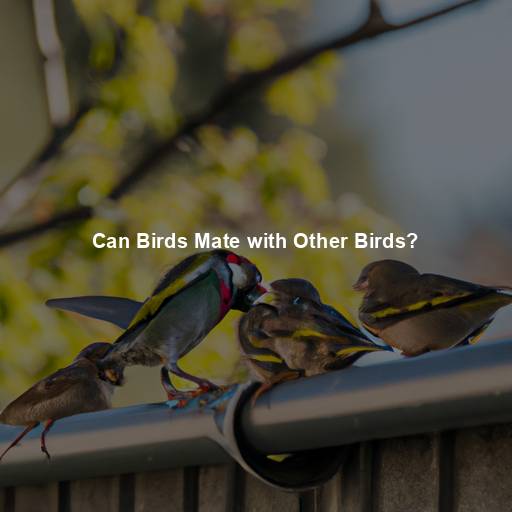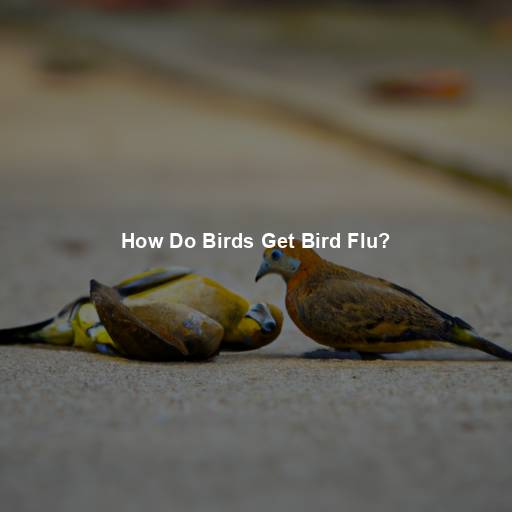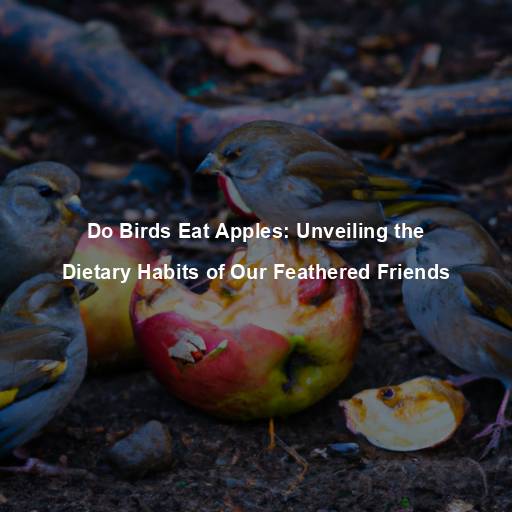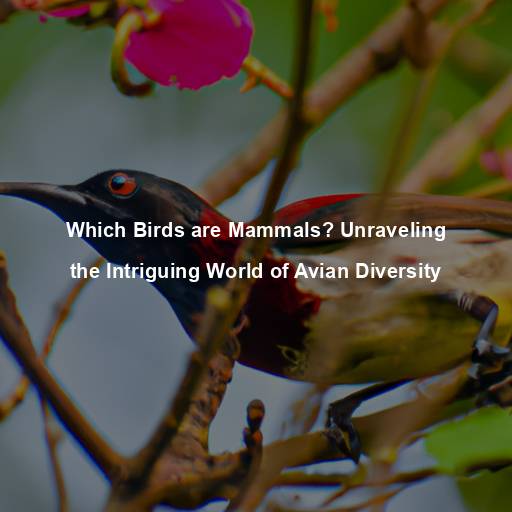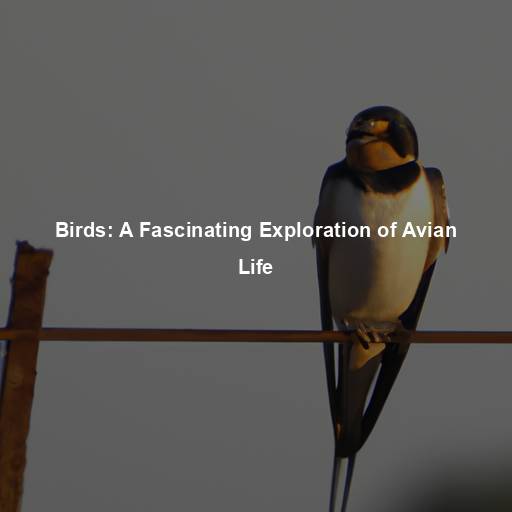Can Birds Mate with Other Birds?
Last Updated on October 28, 2023 by Evan
Contents [hide]
- 1 Understanding Bird Mating Behaviors
- 1.1 The Importance of Species Recognition
- 1.2 Monogamy: A Common Mating Strategy
- 1.3 Monogamy within Species
- 1.4 Extra-Pair Copulations: Mating Beyond Monogamy
- 1.5 The Evolutionary Advantage of EPCs
- 1.6 Inter-Species Mating: A Rare Phenomenon
- 1.7 Hybridization: The Result of Inter-Species Mating
- 1.8 Challenges and Consequences of Hybridization
- 1.9 Ecological Factors
- 1.10 Courtship Rituals and Vocalizations
- 1.11 Genetic Compatibility
- 1.12 Hybrid Viability and Fitness
- 1.13 Environmental Pressures and Adaptation
- 2 Examples of Inter-Species Mating in Birds
- 2.1 Mallard and American Black Duck
- 2.2 Blue-winged and Golden-winged Warblers
- 2.3 Gulls and Terns
- 2.4 Implications and Conservation Considerations
- 2.5 Conservation Concerns
- 2.6 Positive Impacts of Hybridization
- 2.7 Negative Impacts of Hybridization
- 2.8 Threats to Endangered Species
- 2.9 Managing Hybridization in Conservation
- 2.10 Future Research and Conservation Efforts
- 3 FAQs – Can Birds Mate with Other Birds?
Understanding Bird Mating Behaviors
Birds, with their vibrant plumage and melodious songs, captivate our hearts and inspire awe in nature enthusiasts. While we often admire their beauty from a distance, it is natural to wonder about their mating habits. Do birds mate exclusively with their own species, or can they form relationships with other bird species? Let us delve into the fascinating world of bird mating behaviors to find the answers.
The Importance of Species Recognition
Welcome to the mesmerizing world of avian love affairs, where life’s ultimate purpose intertwines with a symphony of diversity. With whimsical courtship rituals and striking vocalizations, birds embark on a tantalizing journey of species recognition that tantalizes the senses. Through a captivating dance of unique visual cues, adorned with vibrant plumage, these enchanting creatures navigate the perplexing labyrinth of love to ensure the continuation of their kind, ensuring a tapestry of vibrant species flourishes in the ever-changing tapestry of nature.
Monogamy: A Common Mating Strategy
Monogamy is a prevalent mating strategy observed in numerous bird species. In monogamous relationships, a male and a female form a long-term bond and share responsibilities in raising their offspring. This bond may last for a breeding season or, in some cases, for life.
Monogamy within Species
Birds, those marvelous creatures who grace our skies, have their own unique approach to love and commitment. In the avian world, within-species monogamy reigns supreme, captivating our imaginations with its captivating elegance. As if taken from a romantic novel, male and female birds of the same species join forces, embarking on a breathtaking journey of courtship and bonding. These devoted pairs, driven by a primordial instinct to ensure the survival of their genetic legacy, pledge their loyalty in the pursuit of perpetuating their lineage within their own feathery realm.
Extra-Pair Copulations: Mating Beyond Monogamy
In the avian world, love can be a captivating and complex affair. While some feathered friends adhere faithfully to the monogamous lifestyle, others veer into uncharted territories of passion. Enter the enigmatic realm of extra-pair copulations (EPCs), where birds venture beyond the boundaries of their established pair bonds to seek amorous encounters with other avian suitors. This fascinating behavior casts a veil of intrigue over the presumed monogamy that once seemed absolute within bird populations.
The Evolutionary Advantage of EPCs
The presence of extra-pair copulations (EPCs) among bird species may initially spark confusion, defying the conventional notion of exclusive monogamy. Yet, delving deeper into the evolutionary context unveils a myriad of potential benefits. Embracing EPCs enables birds to enrich their genetic pool, potentially elevating the vitality of their descendants. It ushers in fresh genes, fostering adaptability and fortitude within the populace.
Inter-Species Mating: A Rare Phenomenon
While birds may engage in EPCs, inter-species mating is a relatively rare phenomenon. Generally, birds prefer to mate with individuals of their own species due to the requirements of species recognition and compatible courtship behaviors. Inter-species mating is more likely to occur between closely related bird species that share similar ecological niches or habitats.
Hybridization: The Result of Inter-Species Mating
When inter-species mating does occur, it can lead to hybridization—the production of offspring with mixed genetic traits from both parent species. Hybridization is often observed when closely related bird species come into contact and breed in areas where their ranges overlap. These hybrids may possess unique characteristics and behaviors that differ from both parent species.
Challenges and Consequences of Hybridization
Hybridization can have both positive and negative consequences. On one hand, it can contribute to the diversification of bird species and promote genetic variation. On the other hand, hybridization can also lead to the dilution of genetic integrity within species and potentially disrupt local ecosystems. The long-term effects of hybridization on bird populations are still a subject of scientific study and debate.
Ecological Factors
Birds, those elusive and captivating creatures, behold a perplexing phenomenon – the phenomenon of inter-species mating. As these feathered beings traverse their chosen habitats, their paths may intertwine, leading to unforeseen encounters. When parallel worlds collide, when two distinct bird species occupy the same geographical arena, something extraordinary happens – the boundaries blur, and the possibility of interbreeding emerges like a shimmering mirage. In these moments of chance and serendipity, nature reveals her intricate tapestry, inviting avian souls to dance on the edge of possibility.
Courtship Rituals and Vocalizations
Birds, known for their exquisite courtship rituals and enchanting vocalizations, embark on a captivating dance of love. These enchanting behaviors serve as a melodious symphony of attraction, ensuring the attention of potential mates and paving the way for species recognition. The delicate balance lies within the compatibility of courtship displays and harmonious tunes between two bird species, ultimately determining the chances of inter-species romance. However, if these bewitching displays and lyrical melodies fail to resonate with individuals from another species, the dance of love may end prematurely, leaving the potential for a successful mating to flutter away.
Genetic Compatibility
The intricate dance of romance in the avian world goes beyond mere attraction and courtship rituals. Genetic compatibility takes center stage as a crucial factor in the delicate ballet of inter-species mating. This compatibility, or lack thereof, can make or break the chances of successful reproduction – a harmonious blending of genetic material that paves the way for the creation of thriving offspring. When species diverge genetically, these differences can act as mysterious barriers, casting a shadow of uncertainty over the possibility of interbreeding and shaping the destiny of avian love stories.
Hybrid Viability and Fitness
The intricate dance of inter-species mating in the avian world is a captivating spectacle, full of perplexing twists and turns. The fate of hybrid offspring born from the union of different species holds the key to unraveling this enigmatic phenomenon. These hybrids, while fascinating in their own right, often face a bewildering challenge in establishing themselves as viable populations due to reduced fertility and diminished vitality. As a result, the threads that weave this tapestry of inter-species love remain rare and elusive in the avian community.
Environmental Pressures and Adaptation
Environmental pressures and the need for adaptation can also impact inter-species mating in birds. If the environment undergoes rapid changes or presents new challenges, individuals may explore alternative mating strategies, including interbreeding with related species. This adaptability can provide a potential advantage for survival and successful reproduction in dynamic environments.
Examples of Inter-Species Mating in Birds
Mallard and American Black Duck
One well-known example of inter-species mating in birds involves the Mallard (Anas platyrhynchos) and the American Black Duck (Anas rubripes). These two species are closely related and can interbreed, producing hybrid offspring. The hybrids, known as “Mallard x American Black Duck hybrids,” exhibit intermediate characteristics between the two parent species.
Blue-winged and Golden-winged Warblers
In the vast realm of avian wonders, the Blue-winged Warbler and the Golden-winged Warbler stand as captivating species that sometimes find themselves entangled in a perplexing dance of crossbreeding. In these enigmatic moments, their hybrid progeny, known as Brewster’s Warbler and Lawrence’s Warbler, emerge, adorned with a striking fusion of traits inherited from their illustrious parents. Yet, amidst this ethereal tapestry, a haunting concern looms over the Golden-winged Warbler’s conservation, for the intermingling with its Blue-winged counterpart poses a potential threat to its delicate genetic integrity.
Gulls and Terns
Gulls and terns, two groups of seabirds, have been known to engage in inter-species mating. For example, the Herring Gull (Larus argentatus) and the Lesser Black-backed Gull (Larus fuscus) have been observed producing hybrid offspring. Similarly, the Arctic Tern (Sterna paradisaea) and the Common Tern (Sterna hirundo) have been known to interbreed, resulting in hybrid individuals.
Implications and Conservation Considerations
The mingling of love between different bird species has given rise to a captivating conundrum in the realm of conservation. The bewilderment lies in the potential perils posed by these interspecies unions, as they introduce a most puzzling predicament – the looming threat of genetic dilution and disturbances in delicate local ecosystems. With endangered species hanging by a fragile thread, the vigilant gaze of conservationists becomes imperative in tirelessly scrutinizing and steering situations where species partake in forbidden love, ensuring survival and safeguarding the genetic harmony of our precious populations.
Exploring the intricate web of factors that entangle inter-species mating unveils a perplexing realm of possibilities. This enigmatic puzzle presents an opportunity to unravel the mysteries that shape the future of biodiversity. With meticulous scrutiny of genetic compatibility, reproductive triumph, and the far-reaching ramifications of hybridization, scientists emerge as architects of change. Armed with these insights, strategic conservation measures can be crafted, safeguarding the delicate tapestry of bird species and safeguarding their evolutionary trajectory.
Conservation Concerns
While inter-species mating and hybridization in birds can provide valuable insights into the evolutionary process, it also raises concerns regarding conservation efforts. Hybridization can have both positive and negative impacts on bird populations, and understanding these implications is crucial for effective conservation strategies.
Positive Impacts of Hybridization
In some cases, hybridization can contribute to the genetic diversity and adaptive potential of bird species. Hybrid individuals may possess unique combinations of traits that allow them to thrive in new or changing environments. These hybrids can potentially colonize new habitats or fill ecological niches that their parent species cannot occupy. This adaptability can increase the resilience of bird populations in the face of environmental challenges.
Negative Impacts of Hybridization
While hybridization can bring about positive outcomes, it can also have negative consequences for bird populations. When hybridization occurs between closely related species, it can lead to the loss of genetic integrity within each parent species. This dilution of genetic distinctiveness can reduce the ability of species to adapt and evolve, making them more vulnerable to environmental pressures and potential extinction.
Threats to Endangered Species
The intermingling of endangered bird species with more populous or invasive counterparts presents a complex and formidable challenge. As these fragile species hybridize, the very essence of their genetic makeup is at risk of being diluted and compromised. This intricate dance between different avian populations threatens to impede the noble conservation endeavors dedicated to safeguarding the distinct genetic legacies and evolutionary possibilities inherent in endangered birds. An urgent focus on this perplexing issue is crucial to ensure the preservation of these remarkable creatures and their vital contributions to our planet’s biodiversity.
Managing Hybridization in Conservation
Conservationists have been working tirelessly to tackle the complex challenges posed by hybridization. Their diverse range of strategies focus on safeguarding the genetic purity of endangered species and simultaneously fostering the adaptability of bird populations in the face of this phenomenon. These approaches encompass a variety of innovative tactics, seeking to strike a delicate balance between preservation and evolution. By implementing these methods, conservationists strive to navigate the perplexing intricacies of hybridization and ensure a sustainable future for our avian friends.
Genetic Monitoring
Genetic monitoring is crucial for identifying hybridization events and assessing the extent of genetic mixing between species. By analyzing the genetic composition of individuals in populations, researchers can detect hybrid individuals and assess the level of hybridization. This information is essential for designing targeted conservation interventions.
Habitat Management
Creating and maintaining suitable habitats for endangered species can help reduce the likelihood of hybridization with other species. By providing distinct habitats that meet the specific needs of endangered birds, conservationists can minimize the overlap and contact between endangered and hybridizing species.
Captive Breeding Programs
The well-being of endangered bird species hangs in the balance, with captive breeding programs emerging as a forceful ally in their conservation journey. These programs, operating within carefully controlled environments, not only safeguard the existence of these rare avian creatures but also ensure the preservation of their precious genetic heritage. By curbing the peril of hybridization and fostering genetic integrity, conservationists pave the way for these endangered species to persist and flourish amidst the odds stacked against them.
Genetic Rescue
In some cases, genetic rescue may be employed to enhance the genetic diversity of endangered populations. Genetic rescue involves introducing individuals from genetically diverse populations into small or inbred populations of endangered species. This infusion of new genetic material can increase the adaptive potential of endangered populations while minimizing the risk of hybridization.
Future Research and Conservation Efforts
Bird hybridization presents a fascinating and intricate puzzle for scientists, demanding ongoing research to unlock its puzzling complexities. Exploring the genetic, ecological, and behavioral aspects of hybridization holds the key to unveiling innovative conservation strategies that can tackle this perplexing challenge head-on. As our understanding evolves, scientists are empowered to decipher the enigmatic world of bird hybridization, paving the way for more precise and impactful conservation efforts. Every piece of this complex puzzle brings us closer to safeguarding these magnificent creatures and their delicate ecosystems.
Additionally, raising awareness among the general public about the potential impacts of hybridization on bird populations is crucial. Encouraging responsible pet ownership, preventing the release of non-native bird species into the wild, and supporting conservation organizations are all steps that individuals can take to contribute to bird conservation efforts.
FAQs – Can Birds Mate with Other Birds?
Can birds mate with birds of different species?
Yes, birds can mate with birds of different species, but the chances of successful mating resulting in fertile offspring are usually very low. Generally, birds of different species have different mating behaviors, courtship rituals, and reproductive anatomy, which can make successful mating and reproduction difficult. However, there are a few documented cases of hybridization between closely related bird species.
Can birds mate with birds of the same gender?
Yes, birds can mate with birds of the same gender. Same-sex pairings have been observed in many bird species, both in captivity and in the wild. While these pairs cannot produce offspring naturally, they may display various behaviors similar to breeding pairs, such as nest-building, territorial defense, and even some forms of courtship.
How do birds find a mate?
The world of bird romance is a swirling vortex of strategies and tactics, a kaleidoscope of behaviors that leave us humans in awe and confusion. From intricate courtship displays that involve a combination of song, dance, and showy feathers, to gravity-defying aerial acrobatics, birds leave no stone unturned in their quest for love. But it doesn’t stop there – these feathered Casanovas also rely on their voices, employing a range of calls and vocal patterns that would give any opera singer a run for their money. And let’s not forget about the importance of migration, social interactions, and territorial posturing in the grand symphony of bird love. It’s a world of mystery and unpredictability, where love knows no boundaries.
How do birds reproduce?
Birds reproduce sexually, with males fertilizing the eggs produced by females. Female birds typically lay eggs in nests constructed by both parents or specifically by the female. The male and female take turns incubating the eggs, ensuring their warmth and protection until they eventually hatch. Once hatched, the parents usually care for and feed the chicks until they are able to leave the nest and fend for themselves.
Can birds mate for life?
In the awe-inspiring world of birds, there exists a captivating dance of relationships. While certain winged wonders have been known to embark on enchanting journeys of monogamy, pledging their feathery hearts to one partner for a lifetime, the avian realm is a mosaic of diverse mating habits. Some birds engage in an intriguing game of serial monogamy, where love takes flight with multiple partners throughout their existence. On the other hand, there are those feathered individuals who embrace a more unorthodox approach, embracing the concept of polygamy and the tangled web of multiple mates. With each flap of their wings, these creatures present a captivating study of love and partnership in the realm of feathers and beaks.
Can birds mate with other animals?
Birds are generally unable to mate with animals of different species. Although rare cases of hybridization involving closely related bird species have been documented, mating between birds and other animal groups such as mammals or reptiles is highly unlikely due to the fundamental differences in reproductive systems and genetic compatibility between different animal taxa.

